Table of Contents
If you’re building a course business, you already know it’s not just about publishing content. It’s about selling it—reliably, smoothly, and in a way that scales with you. Most learning management systems do an okay job at hosting content. But when it comes to growing course sales, offering flexible pricing, or handling payments securely, too many of them fall short. That’s where a lot of creators and educators hit a wall.
I’ve spoken to course sellers who are juggling separate tools just to process payments. Others who’ve had international customers abandon checkout because their platform didn’t support multiple currencies or proper tax handling. These aren’t nice-to-haves. They’re business blockers.
In this guide, I’ll help you:
Why ecommerce features matter in an LMS
When I talk to course creators who’ve hit a plateau, it’s rarely about the content. It’s almost always the same issue: their platform doesn’t support the way they want to sell.
That might look like:
If you’re serious about course sales, your LMS should do more than host content. It needs to support your business model end-to-end—from pricing plans to payment gateways, bulk sales, discount codes, and tracking learner progress and course performance.
And if you’re running compliance training, blended learning, or managing customer data for external partners, that complexity only grows. You don’t want to build a house of tools. You want an all-in-one platform that fits your workflows and gets out of the way.
Here’s what to look for:
If your LMS can’t do those things, you’re leaving money on the table.
The rise of selling courses online
Not long ago, selling courses online was mostly for universities, big companies, or a few early adopters. That’s changed. Today, anyone with valuable knowledge can reach a global audience—and the tools to build a course business are more accessible than ever.
But with opportunity comes competition.
If you want to stand out, it’s not enough to offer great course content. You also need to offer a smooth learning experience, use smart marketing tools, and treat your courses like digital products that need real ecommerce capabilities behind them.
I see creators succeeding when they focus on:
The course industry is moving fast. Selling online isn’t a side project anymore—it’s a serious business model. And the platforms that combine strong course management with powerful marketing integrations and tools for accepting international payments, streamlining the checkout process, boosting sales, and automating routine tasks, like managing invoices and refunds, are the ones setting creators up for real growth.
Monetization challenges and solutions for education businesses
If creating a course is hard, turning it into a predictable revenue stream can feel even harder. I see the same roadblocks come up again and again for course creators and education businesses trying to scale.
Common monetization challenges:
Most creators don’t fail because they lack great courses. They struggle because their tech stack isn’t built for selling courses at scale.
What actually solves these problems:
Your LMS shouldn’t just manage your content. It should drive your course sales forward, help you test pricing strategies, and make it easy to scale internationally without adding more tools to your tech stack.
Overview of LMS platforms with integrated ecommerce features
When I started looking at LMS platforms through the lens of selling—not just hosting—I realized how different they actually are.
Some platforms are great for course creation but leave you patching together external tools just to process payments or offer a subscription plan. Others nail the payment gateways but treat your course content like an afterthought.
If you’re serious about scaling course sales, you need a platform that combines strong learning management system (LMS) features with real ecommerce capabilities—in one place.
Here’s a quick snapshot of the top platforms I’m focusing on in this guide:
If you’re aiming to sell courses online, manage bulk enrollments, process payments securely, and track course performance, choosing the right platform can either make scaling seamless—or incredibly frustrating.
Key features to look for in an ecommerce LMS
When you’re evaluating platforms, it’s tempting to focus on the basics: uploading learning content, enrolling students, maybe setting up a simple payment page.
But if you want to sell courses online and actually grow your business, you need more than basic. You need a platform that treats ecommerce as a core part of your success—not just an add-on.
Here’s what I always recommend looking for:
Flexible revenue and pricing models
If you can’t customize your pricing, you’ll leave too much potential revenue on the table.
Streamlined purchasing experiences
The fewer the checkout obstacles, the higher your course enrollments and course sales.
Optimizing demand through scarcity
Scarcity done right boosts both perceived value and conversions.
Scaling to global markets
If you’re thinking globally (and you should), your platform needs to handle the complexity for you.
Empowering data-driven decisions
The more you know about your buyers, the smarter your offers—and your growth—will become.
Recurring revenue opportunities
Recurring revenue isn’t a nice-to-have—it’s what makes your course business sustainable over time.
Over the next sections, I’ll break down these platforms one by one, looking specifically at how they handle the ecommerce side of your business: from flexible pricing and transaction fees to payment processing and customer data management.
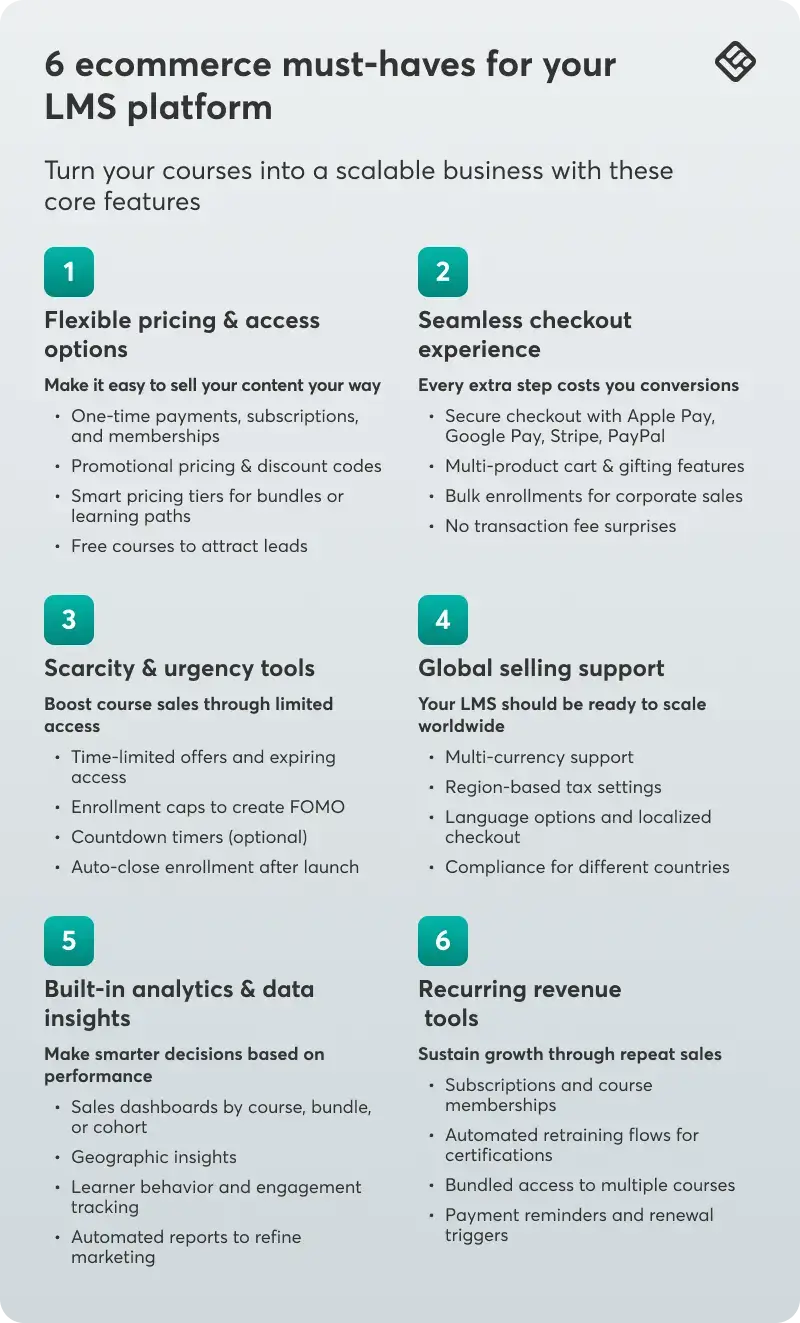
Top ecommerce LMS platforms
LearnWorlds
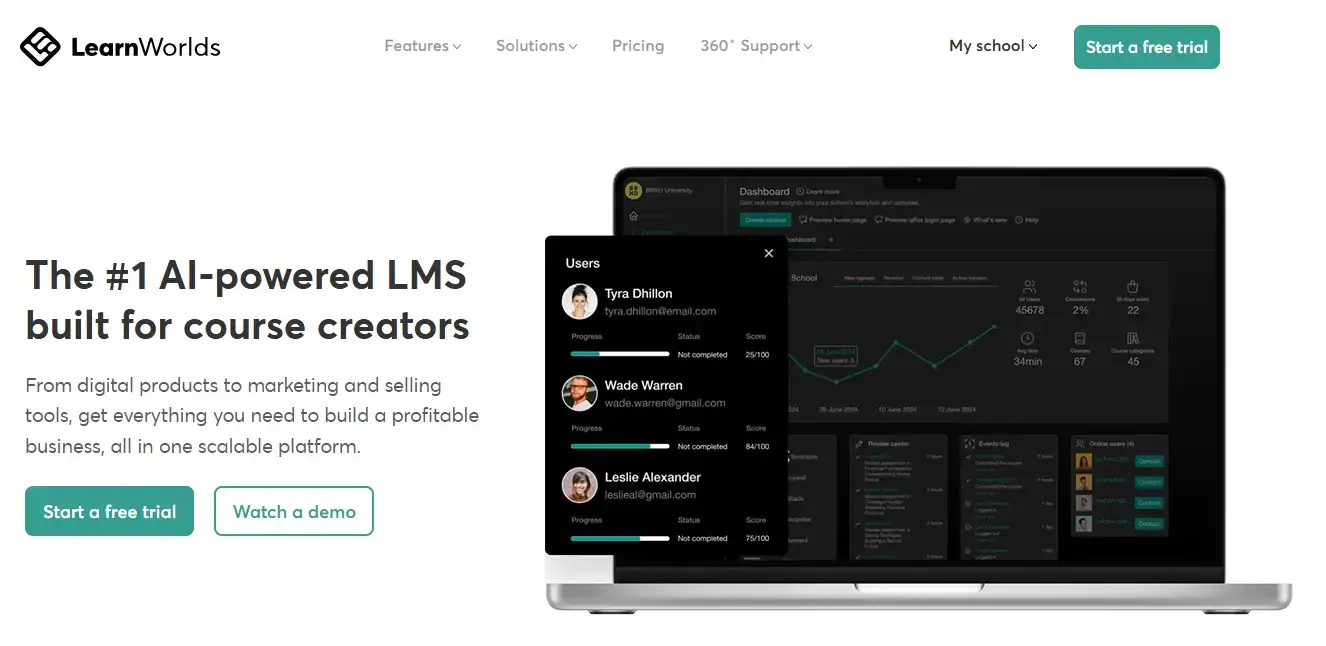
When it comes to selling courses at scale, LearnWorlds stands out. It’s not just another hosting platform with basic checkout options—it’s built from the ground up to help course creators grow a real business.
Here’s why I recommend it if you’re serious about scaling:
I especially like how LearnWorlds makes it easy to process payments securely, track course performance, and offer flexible pricing models that work for your business—all inside an intuitive interface designed for creators, not developers.
If you’re offering specific courses like compliance training, running virtual classrooms, or aiming for recurring revenue through memberships, LearnWorlds gives you the flexibility you need, without forcing you to build a complicated tech stack.
It’s an all-in-one platform that doesn’t feel bloated—and it’s built for course creators who think like business owners.





Pros & Cons
Pros
- Built-in e-commerce engine that enables you to run all your revenue operations𑁋from marketing your offerings to getting paid𑁋inside your LMS
- Flexible pricing and monetization options that fit your business model
- Tools that drive sales: lead magnets, sales funnels, coupons, promotions, and more
- Deep analytics for course sales and learner behavior
- Multiple currencies (coming soon), secure payment processing, built-in invoicing (coming soon), refunds and recurring plans management (coming soon)
- Powerful AI-assisted course creation features like auto-generated course outlines and assessments, subtitles and video transcripts for your videos, and more
Cons
- Best suited for creators who want to scale, not just host a few videos
- Steeper learning curve
Pricing
LearnWorlds offers multiple pricing tiers depending on your needs:
There’s a 30-day free trial, no credit card required. Pricing scales fairly with the features—especially if you’re planning to grow or manage a catalog of courses.
* Pricing retrieved from LearnWorlds on April 30, 2025
Thinkific Plus
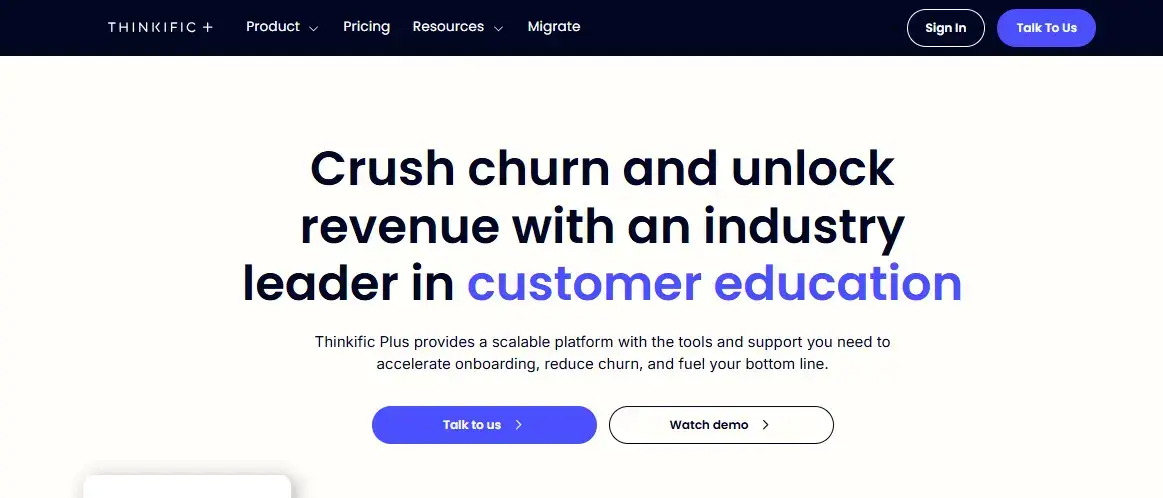
Thinkific Plus is a strong option for course creators who prioritize a simple checkout experience and basic ecommerce flows without needing heavy customization.
It covers the essentials well:
Thinkific Plus is a solid choice if your course business focuses mainly on single-course sales or small membership programs.
That said, if you’re planning to grow internationally or want more control over flexible pricing options, smart pricing strategies, bulk sales, or multiple currencies, Thinkific may feel limiting over time. You’ll also need to rely on external tools if you want more advanced features, like in-depth sales performance analytics beyond basic transaction reports.





Pros & Cons
Pros
- Clean checkout flows
- Easy-to-use course creation and enrollment tools
- Strong for basic memberships and simple sales
Cons
- Limited built-in ecommerce flexibility for scaling businesses
- Fewer options for promotional pricing, gifting, or cohort-based analysis
- Requires third-party apps for features that LearnWorlds offers natively (e.g., interactive video is not available with Thinkific)
Pricing
No publicly available pricing (before introducing a tiered Thinkific Plus plan, starting price was $950/month)
It includes:
There’s no free trial for Thinkific Plus, but there is for their lower-tier plans. Keep in mind: many ecommerce and analytics features only unlock at higher tiers or with additional apps.
* Pricing retrieved from Thinkific on April 30, 2025
Arlo
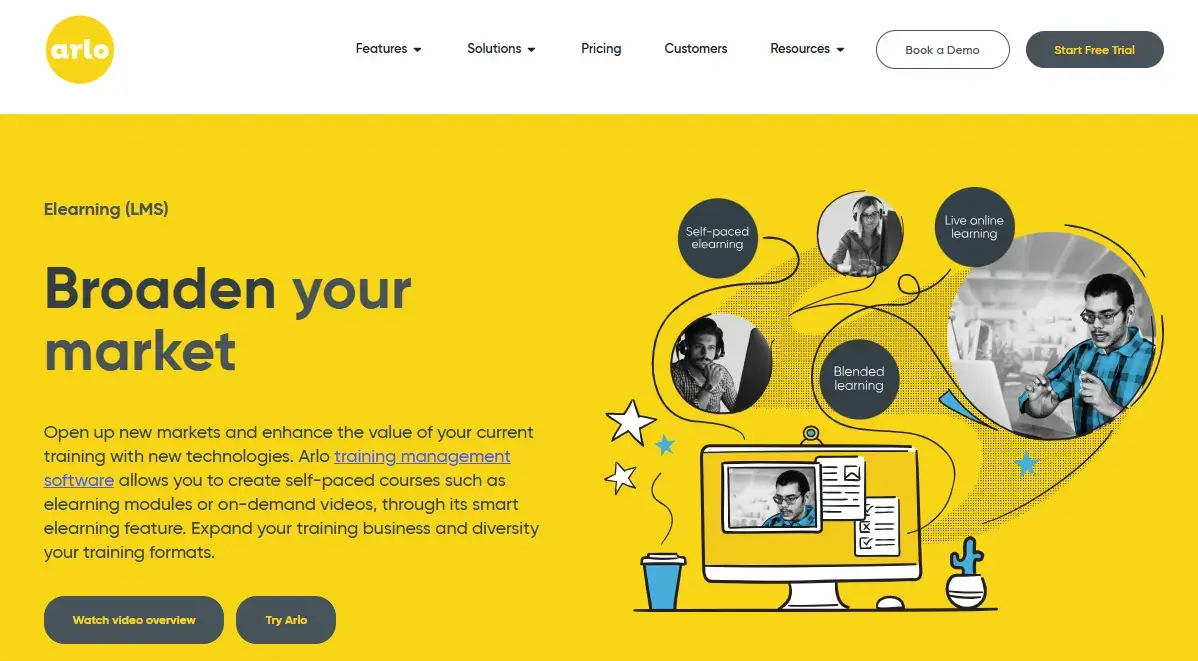
Arlo isn’t your typical course platform. It’s designed with training providers and corporate learning teams in mind—especially those running blended learning programs that combine in-person and online experiences.
Where Arlo shines:
If your business revolves around delivering workshops or managing multiple cohorts across organizations, Arlo could be a good fit.
But if your primary goal is to sell courses online at scale—especially to individuals—Arlo has some limitations:
So while Arlo does well in structured training environments, it’s not built with the same ecommerce-first mindset that platforms like LearnWorlds bring to creators and educators selling directly to consumers.





Pros & Cons
Pros
- Great for blended and in-person training
- Strong corporate features like team enrollments and CRM integrations
- Handles scheduling, calendar invites, and session logistics with ease
Cons
- Ecommerce features feel secondary
- Lacks interactive course tools and modern checkout flexibility
- Not ideal for high-volume individual sales or global scalability
Pricing
Arlo offers four structured pricing plans designed for training providers, with pricing based on both administrator access and registration volume:
All plans include secure checkout, support for integrations, and CRM capabilities. Additional charges apply for optional services like implementation, website integration, or learning design.
Free 14-day trial available, no credit card required.
* Pricing retrieved from Arlo on April 30, 2025
eLeaP
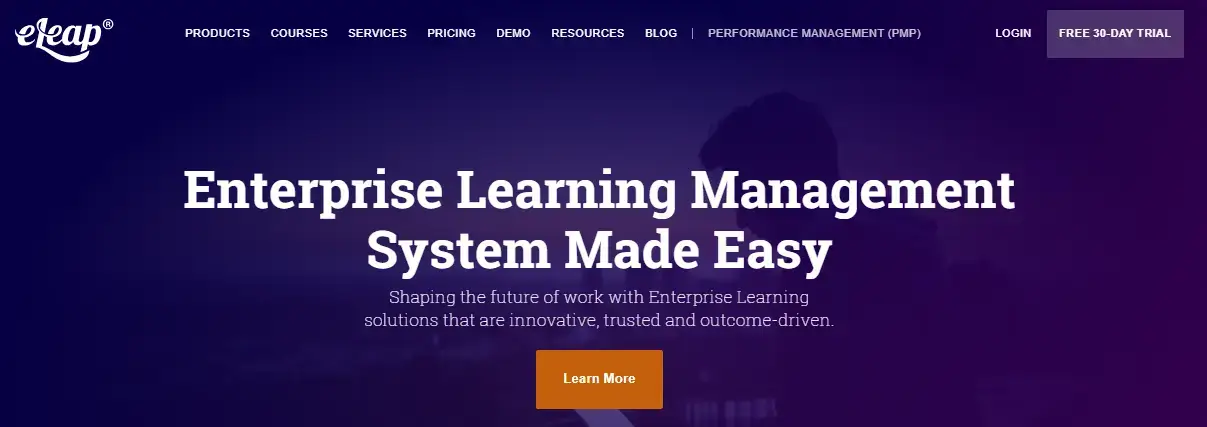
eLeaP positions itself as a customizable LMS with a strong focus on certification, compliance, and training content delivery—especially for corporate and enterprise learning.
If you’re looking for flexibility in setup and need to support specific courses that require assessments, audits, or documented tracking, eLeaP delivers on those fronts. It supports:
It’s especially useful for HR teams, training departments, or vendors who need a system tailored to regulatory standards.
But from an ecommerce perspective, eLeaP isn’t the most accessible option:
In other words, eLeaP offers powerful backend flexibility, but without the out-of-the-box ecommerce capabilities that creators using platforms like LearnWorlds might expect.





Pros & Cons
Pros
- Solid for enterprise-grade compliance and certification programs
- Strong assessment features and multimedia support
- Custom setups for unique training needs
Cons
- Ecommerce setup isn’t beginner-friendly
- Lacks advanced pricing and checkout options
- Fewer tools for marketing, course bundles, and upsells
Pricing
eLeaP uses quote-based pricing depending on your team size and requirements.
Rough estimates:
There’s no public pricing for ecommerce add-ons—many features require consultation or technical setup.
Best suited for companies with a clear compliance or certification training budget.
* Pricing retrieved from eLeaP on April 30, 2025
How to choose the right platform for you
It’s easy to get overwhelmed comparing features. I’ve been there—scrolling through endless product pages, pricing tables, and demo videos, trying to figure out what actually matters.
Here’s how I simplify it: I look at the business model first, not the feature checklist. Start with these questions:
1. How do you plan to make money from your courses?
Are you selling a single course at a fixed price? Launching a membership? Running compliance training for corporate teams?
2. Who’s your audience—and where are they?
If your learners are global, your LMS should handle multiple currencies, regional tax compliance, and flexible pricing plans.
If you’re working locally, make sure your payment gateways are optimized for your region (Stripe, Apple Pay, Google Pay, etc.).
Platforms like LearnWorlds take care of this out of the box. Others may need integrations or custom work.
3. What kind of learning experience do you want to offer?
If your brand depends on engaging courses, interactive features, and learning paths, don’t compromise on content delivery. Look for built-in tools that support interactive elements, virtual classrooms, and learner engagement.
If your main value is access to the material (like in compliance or certification programs), prioritize strong assessment tools, certificates, and learner tracking.
4. How much control do you want over the purchase experience?
If you want to offer gifting, discount codes, promotional pricing, or a smooth cart experience with multiple payment options, you’ll want a platform with a mature ecommerce engine—not just a Stripe plugin.
Thinkific and eLeaP give you some control here, but LearnWorlds goes further by offering smart pricing, secure payment processing, and a full cart system (coming soon) that supports everything from free courses to complex bulk enrollments.
5. Are you trying to grow or just get started?
If you’re testing the waters with a free course, just about any LMS will do. But if your goal is long-term growth, look at platforms that scale with you—where you won’t hit a ceiling on ecommerce, analytics, or integrations six months down the line.
Your course platform shouldn’t dictate how you run your business. It should support the business you’re building—and give you room to grow.
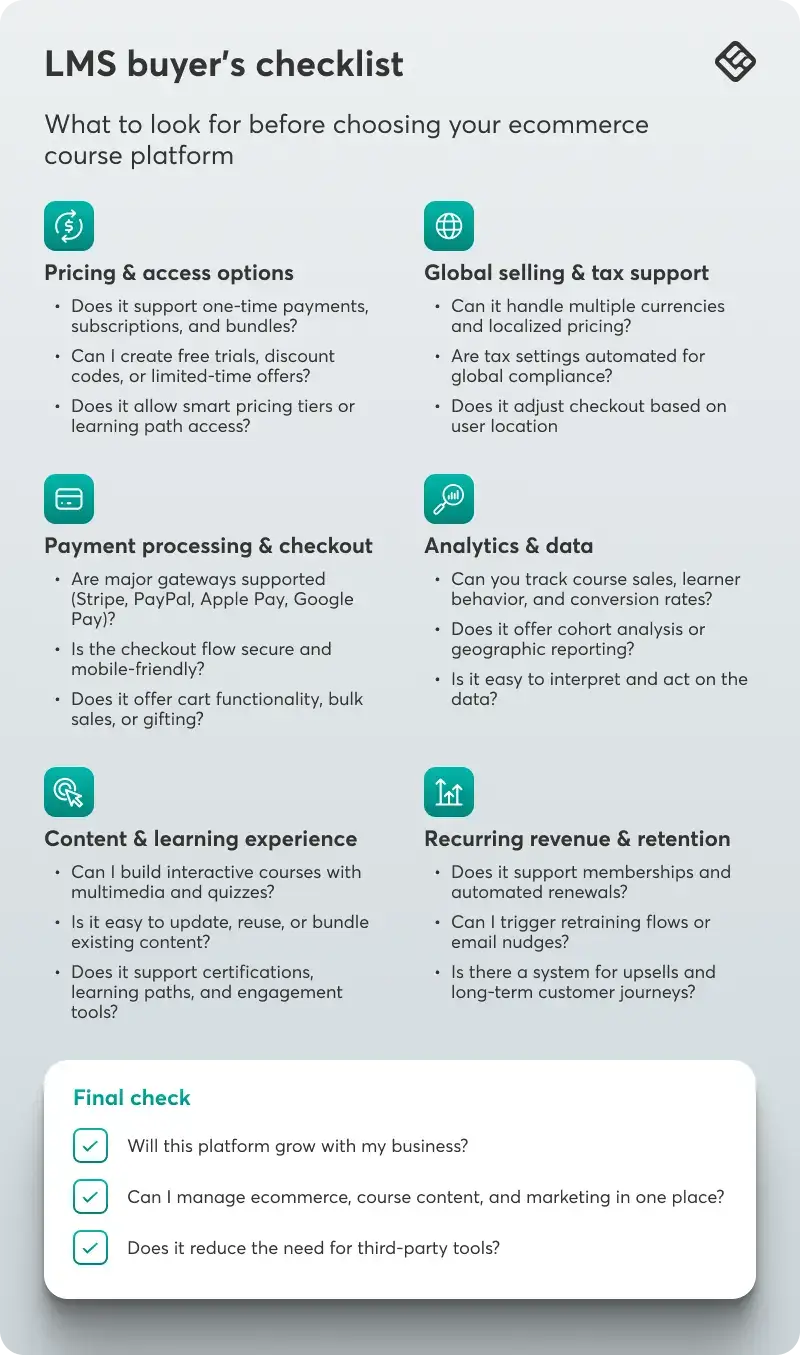
Final thoughts
Selling courses isn’t just about content anymore—it’s about the full experience: how learners discover your course, how they pay, and how you guide them through to results.
If your LMS can’t support flexible pricing, multiple payment gateways, or track course performance with real data, it’s going to hold you back. Especially if you’re trying to scale.
After comparing the top platforms out there, here’s my take:
The best LMS for you depends on your goals. But if you’re here because you’re trying to sell courses online seriously—not just host them—start by making sure your platform actually supports that business model.
Start a 30-day free trial with LearnWorlds and see how it supports everything from interactive content and secure payments to advanced ecommerce features—without needing extra tools.
Explore next:
Rosemary is LearnWorlds’ Content Marketing Manager. She has over 2 decades of experience in omnichannel marketing and content writing for the IT and SaaS industry. Her expertise lies in crafting effective content marketing strategies that attract, engage, and nurture customers, enabling LearnWorlds to reach its target audiences with precision.


